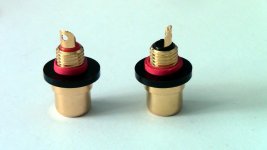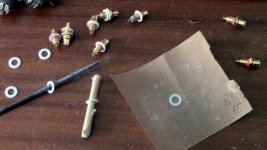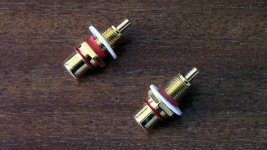Would that be helpful, would that tell you something about the sound? Graphs are much clearer then with v1.2 😉Any progress on this? Did I miss anything?
I'm just working on S and L modules, as expected in march to be available.I'm interested to ask when is planed to announce FO 1.4S?
Heatsinks and the rest of the chassis were not grounded even before, only RF decoupling, otherwise complete galvanic isolation from chassis to module.
Interesting. My 1.2 never worked stable if the shared between the two channels heatsink was not grounded. Today i finally got to install the 2mm oxide spacers between the outputs and the sink and surprise: it's still not stable if the sink is not grounded. All is fine on the bench but once long speaker cables are attached it goes crazy. Grounding the sink sorts it out, but is obviously a bad idea as it creates a potential ground loop.
All v1.4 amps assembled by me and there are lots of them, not anyone grounded, earthed yes (GND lift). No hum or hiss or any unstability whatsoever.
Analog and LC,
From what I have always seen the heatsink is normally connected in series with the chassis, in effect it is a ground plane. What happens if the heatsink is galvanically isolated from the rest of the chassis, floating in effect? You would lose the earth ground that is normal to a chassis and would seem like it would remove any potential ground loop if the output devices are also isolated as normal from the heatsinks.
From what I have always seen the heatsink is normally connected in series with the chassis, in effect it is a ground plane. What happens if the heatsink is galvanically isolated from the rest of the chassis, floating in effect? You would lose the earth ground that is normal to a chassis and would seem like it would remove any potential ground loop if the output devices are also isolated as normal from the heatsinks.
All v1.4 amps assembled by me and there are lots of them, not anyone grounded, earthed yes (GND lift). No hum or hiss or any unstability whatsoever.
Not arguing about the 1.4 at all: your remark concerned the 1.2/1.3 as well and all i can say is that these are not unconditionally stable with a floating sink.
Would that be helpful, would that tell you something about the sound?
It wouldn't tell much about the sound, but it would provide some objective information about the performance and quality of the design.
Graphs are much clearer then with v1.2 😉
The v1.2 was a different design, as far as I can tell.
Hardware questions
Two questions regarding hardware component choices:
Is it worth getting an IEC socket with EMI rejection, as the SMPS has quite a bit of EMI rejection as is?
Also, what should the main power switch be rated as with two paralleled SMPS? 15 or 20 amps? Based on the 250 Vac, 12 Amp fuse needed for each SMPS, I am thinking I need the 20 Amp switch. Is my thinking on this right?
(less choices with 20 amps switches 🙁)
Two questions regarding hardware component choices:
Is it worth getting an IEC socket with EMI rejection, as the SMPS has quite a bit of EMI rejection as is?
Also, what should the main power switch be rated as with two paralleled SMPS? 15 or 20 amps? Based on the 250 Vac, 12 Amp fuse needed for each SMPS, I am thinking I need the 20 Amp switch. Is my thinking on this right?
(less choices with 20 amps switches 🙁)
Hardware induced Hum
I am sure most of You have figured this out already, but I am sharing this, because I have overlooked this a couple of times. 😱 Most RCA Jacks and Binding Posts have pads that mostly insulates the part from the faces of a metal earthed chassis. But these pads do not insulate the shaft itself - the part penetrating thru the hole in the chassis wall. If the part is perfectly centered in a larger hole, no problem, air is a great insulator. But, what has happened to me, is the part moves when tightening - so the shaft ends up touching the chassis; therefore connecting the signal ground to the earth ground and causing a hum. 😱 I solved this problem by covering the shaft with wire shrink wrap cut to the thickness of the chassis wall. Of course, I had to enlarge the holes on the insulation pads also, but this worked, no more hum. 🙂
I wish manufactures took this into consideration when they manufacture their parts, but then again, they do not know the thickness of an end users chassis walls either. 😉
I hope this helps
Allen
I am sure most of You have figured this out already, but I am sharing this, because I have overlooked this a couple of times. 😱 Most RCA Jacks and Binding Posts have pads that mostly insulates the part from the faces of a metal earthed chassis. But these pads do not insulate the shaft itself - the part penetrating thru the hole in the chassis wall. If the part is perfectly centered in a larger hole, no problem, air is a great insulator. But, what has happened to me, is the part moves when tightening - so the shaft ends up touching the chassis; therefore connecting the signal ground to the earth ground and causing a hum. 😱 I solved this problem by covering the shaft with wire shrink wrap cut to the thickness of the chassis wall. Of course, I had to enlarge the holes on the insulation pads also, but this worked, no more hum. 🙂
I wish manufactures took this into consideration when they manufacture their parts, but then again, they do not know the thickness of an end users chassis walls either. 😉
I hope this helps
Allen
Attachments
Last edited:
Additional fuses
That is why I am asking. 😱
I got the fuse rating from the Hypex 1200 SMPS manual. It does not mention much about 110 voltage, except that the jumper on pin J3.1-2 must be closed for 115 volts. I did notice that this fuse is soldered into the SMPS and is not user replaceable, so this must be a "last resort" type of thing. I am thinking if this fuse blows, You need a new SMPS. 😱
http://www.hypex.nl/docs/SMPS1200_datasheet.pdf
So that poses a third hardware question. Do you guys recommend additional fuses between both the IEC and each SMPS, and the SMPS and AMP Modules?
If so, what ratings?
Allen
Artsy,
But your in the USA with 110V power. So that doesn't seem correct.
That is why I am asking. 😱
I got the fuse rating from the Hypex 1200 SMPS manual. It does not mention much about 110 voltage, except that the jumper on pin J3.1-2 must be closed for 115 volts. I did notice that this fuse is soldered into the SMPS and is not user replaceable, so this must be a "last resort" type of thing. I am thinking if this fuse blows, You need a new SMPS. 😱
http://www.hypex.nl/docs/SMPS1200_datasheet.pdf
So that poses a third hardware question. Do you guys recommend additional fuses between both the IEC and each SMPS, and the SMPS and AMP Modules?
If so, what ratings?
Allen
Clever trick for ensuring the RCA shaft doesn't contact the chassis. Thanks for sharing.I am sure most of You have figured this out already, but I am sharing this, because I have overlooked this a couple of times. 😱 Most RCA Jacks and Binding Posts have pads that mostly insulates the part from the faces of a metal earthed chassis. But these pads do not insulate the shaft itself - the part penetrating thru the hole in the chassis wall. If the part is perfectly centered in a larger hole, no problem, air is a great insulator. But, what has happened to me, is the part moves when tightening - so the shaft ends up touching the chassis; therefore connecting the signal ground to the earth ground and causing a hum. 😱 I solved this problem by covering the shaft with wire shrink wrap cut to the thickness of the chassis wall. Of course, I had to enlarge the holes on the insulation pads also, but this worked, no more hum. 🙂
I wish manufactures took this into consideration when they manufacture their parts, but then again, they do not know the thickness of an end users chassis walls either. 😉
I hope this helps
Allen
Makes me laugh since the graphs of the amps First One has beaten are impressive.It wouldn't tell much about the sound, but it would provide some objective information about the performance and quality of the design.
I don't get this. Who has beaten what? In what way?Makes me laugh since the graphs of the amps First One has beaten are impressive.
What is your reason for not showing the test results of the 1.4?
I don't get this. Who has beaten what? In what way?
What is your reason for not showing the test results of the 1.4?
In a way on ABX tests in system with B&W802 D3, B&W804 D3 speakers compared to different amps; Rotel, Classe, Onkyo ... showed that less is more. I won't go into details since that is meaningless to someone who hadn't have a chance to listen to any of amps mentioned. Just saying that very nice graphs from any of those amps don't tell you anything about their sound signature. Also they all have 8-16 outputs per channel, what a waste of parts there is. Quality of the sound lie in different department, some on this forum knows all that well but rarely spoken about it openly. First you have to ask yourself why tube amps with disastrous plots sounds fantastic, not all of them of course.
Last edited:
- Home
- Vendor's Bazaar
- First One - mosFET amplifier module



